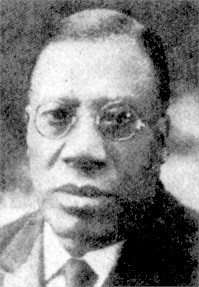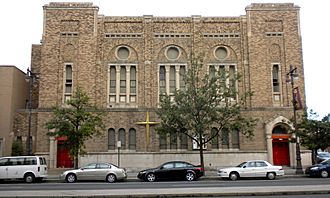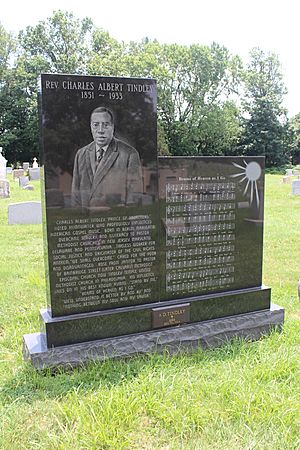Charles Albert Tindley facts for kids
Quick facts for kids
Charles Albert Tindley
|
|
|---|---|
 |
|
| Born |
Charles Tindley
July 7, 1851 Berlin, Maryland, United States
|
| Died | July 26, 1933 (aged 82) Philadelphia, Pennsylvania, U. S.
|
| Occupation | minister, composer |
| Spouse(s) | Daisy Henry |
Charles Albert Tindley (born July 7, 1851 – died July 26, 1933) was an American Methodist minister. He was also a famous composer of gospel music. One of his most famous songs, "I'll Overcome Someday," inspired the well-known American Civil Rights anthem "We Shall Overcome." He also wrote other popular hymns like "(Take Your Burden to the Lord and) Leave It There" (1916) and "What Are They Doing in Heaven?" (1901).
People often called him "The Prince of Preachers." Even though he never went to school, he taught himself to read and learn. He became a minister and started one of the biggest Methodist churches for African Americans on the East Coast of the United States.
Early Life and Learning
Charles Tindley was born a free man. This was because his mother was free. But his father was enslaved. So, Charles knew a lot about slavery and how it affected people.
After the Civil War, he moved to Philadelphia, Pennsylvania. He found a job carrying bricks. He and his wife, Daisy, went to the Bainbridge St. Methodist Episcopal Church. Charles later became the church's sexton, which meant he took care of the building. This job had no salary.
Tindley never went to school. He learned to read by himself. He would sit by firelight and sound out letters. He used pieces of paper with writing that he found.
He became very good at reading. Later, he got help from a synagogue in Philadelphia to learn Hebrew. He also learned Greek by taking a course through the Boston Theological School.
Leading a Growing Church
Even without a college degree, Tindley was able to become a minister. He passed his exams with high scores. He became a Deacon in 1887 and an elder in 1889. The Methodist Episcopal Church often moved its pastors. Tindley served in many places. These included Cape May, New Jersey, Wilmington, Delaware, and Pocomoke, Maryland. In 1900, he became a leader for the Wilmington District.
In 1902, Tindley became the pastor of the same church where he had been a janitor. This was the Bainbridge Street Church. Under his leadership, the church grew very quickly. When he arrived, it had only 130 members.
In 1906, the church moved to a new building. It was renamed East Calvary Methodist Episcopal Church. The new building could hold 900 people. But it was soon full! Over time, the church grew to 10,000 members. People of all races attended. After Tindley passed away, the church was renamed "Tindley Temple." The Tindley Temple United Methodist Church was added to the National Register of Historic Places in 2011.
Tindley knew important people in Philadelphia. He worked with business leaders to help his church members find jobs. He also told members to start their own businesses and buy homes. The church even helped people get loans for houses. Tindley also asked businessmen for food donations. This helped the church feed people in need.
Tindley spoke out against things he thought were wrong. In 1915, he and other leaders protested a movie called The Birth of a Nation. They marched to a theater. During the protest, some people were hurt. Tindley received care for his injuries at home.
Tindley was given special honors. He received a Doctor of Divinity degree from Bennett College and Morgan College in Baltimore, Maryland.
His Famous Songs
Tindley was a very important songwriter and composer. He is seen as one of the founders of American gospel music. Five of his hymns are in the 1989 United Methodist Hymnal. His song "I'll Overcome Someday" is believed to be the start of the Civil Rights anthem "We Shall Overcome."
Another famous hymn is "(Take Your Burden to the Lord and) Leave It There" (1916). Many artists have recorded this song. Other well-known songs include "Stand by Me" (1905) and "What Are They Doing in Heaven?" (1901).
Tindley started publishing his songs in 1901. He released several collections of hymns. These included Soul Echoes in 1905 and New Songs Of Paradise! in 1916. After he died, a collection called New Songs of Paradise, No. 6 (1941) brought together 46 of his hymns. A later book, Beams of Heaven: Hymns of Charles Albert Tindley (1851-1933) (2006), includes all his original verses.
Charles Albert Tindley died on July 26, 1933. He is buried at Eden Cemetery in Collingdale, Pennsylvania.
In Popular Culture
Charles Albert Tindley is the subject of a children's picture book. It was written by poet Carole Boston Weatherford and drawn by artist Bryan Collier.
- Category:Hymns by Charles Albert Tindley



